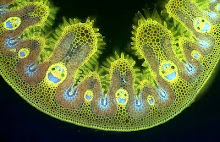A few years ago I was given some seed of Puya chilensis that germinated quickly and produced attractive small pot plants that had one particularly annoying trait. The arching whorls of leaves were fringed with vicious little recurved spines that were forever catching in my clothes or lacerating my skin, so one by one I gave them away to friends who had more space to grow them. On Tuesday, when I visited the National Botanic Garden of Wales I rather regretted that I hadn't been more patient, because their Puya chilensis had a magnificent three metre-tall flower spike. If I'd hung onto my plants for another decade, maybe............
.... or maybe not. I'd probably be permanently scarred by the Puya leaves by now, and you really need a glasshouse like that at the NBGW to flower this magnificent plant reliably. In the wild those recurved spines in the leaves have been known to impale birds and small mammals.
Puya chilensis comes from the coastal mountains of Chile and can be grown outside here in the mildest frost-free areas of Britain, such as the Tresco on the Scilly Isles. But what you really need is ......
........ a glasshouse like this - the magnificent structure designed by Sir Norman Foster for the NBGW.
This is the largest single-span glasshouse in the world, dedicated to displaying the flora of our planet's hotter, drier regions.
The stunning architecture of the building complements the natural architecture of the plants that it houses..........
........ while at the same time blending with its natural surroundings.
The glasshouse follows the contours of the land and reminds me of the carapace of a tortoise. A truely inspirational structure in an inspirational new botanic garden run by passionately committed, enthusiastic people.





















